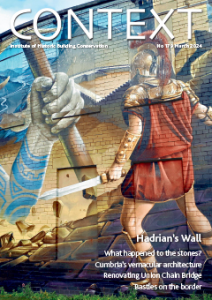 The new issue of the IHBC’s members’ journal, Context, No. 179, offers diverse takes on Hadrian’s Wall – inspired by ‘The man who saved Hadrian’s Wall’ – with a special collation of personal and professional takes on #IHBCReading2024’s theme of ‘Place and Building Care’.
The new issue of the IHBC’s members’ journal, Context, No. 179, offers diverse takes on Hadrian’s Wall – inspired by ‘The man who saved Hadrian’s Wall’ – with a special collation of personal and professional takes on #IHBCReading2024’s theme of ‘Place and Building Care’.
See more on #IHBCReading2024:
CPD Guidance HERE
Booking options HERE
Or just secure your Virtual Day School place + recording
(from £30+VAT) HERE
The IHBC writes:
In 1792, when John Clayton was four years old, his father Nathaniel bought the Chesters Estate, west of Newcastle. This was the site of Chesters Roman fort, and Hadrian’s Wall ran through it. Nathaniel set about levelling and grassing over much of the Roman ruins, but he did collect the Roman antiquities he found there. This sparked the interest of his son, who was dismayed to see the destruction of the Roman ruins.
In time John succeeded his father as town clerk of Newcastle, a post he held for 45 years, proving himself a talented and effective fixer. Among other feats, John Clayton facilitated the builder Richard Grainger’s comprehensive development plan for the centre of Newcastle, with Clayton Street being named after him.
Clayton’s talents made him enormously wealthy, enabling him to pursue his passion for conservation and archaeology. He bought the land occupied by five of the Roman forts and most of a 20-mile stretch of Hadrian’s Wall. He prevented quarrying near to the wall, forbade the reuse of Roman stone in new buildings and cleared buildings constructed on the remains. He built a pavilion to display his archaeological collection, and his nephew Nathaniel later built a permanent museum.
One other thing. John Clayton has been called, by the Northern Echo, among others, ‘the man who planted the Sycamore Gap tree’. That was the tree that stood in a dramatic dip on Hadrian’s Wall until it was felled by vandals in September 2023. The public reaction underlined just how important the wall’s landscape is to so many people. It is true that Clayton was the owner of the land in which the tree was planted, but it seems unlikely that he would have planted a tree so very close to the wall that he was committed to conserving. Whichever way, John Clayton deserves to be celebrated as a hero of conservation.
He and the others who have conserved so much of Hadrian’s Wall and its associated structures over the years have left us plenty to puzzle about. What exactly was the wall’s function? Why was that location chosen, rather than the much shorter route on which the Romans built the Antonine Wall only 20 years later (only to abandon it eight years after completion, withdrawing to Hadrian’s Wall)? How much of today’s visible structure of Hadrian’s Wall is reconstruction?
That history is the starting point for this issue of Context.
Themed articles include:
- Hadrian’s Wall from end to end, Zinnie Denby-Mann
- Hadrian’s Wall Path and the national trails, Polly Martin
- What happened to Hadrian’s Wall? Alexandra Fairclough
- Cumbria’s vernacular architecture and the Roman wall, Peter Messenger
- Discovering bastles, Peter Ryder
- Regeneration in Carlisle Roger Higgins
Feature articles include:
- Union Chain Bridge: crossing the border, Mark Douglas
- Nairn’s Manchester revisited, Ian Wray
- The battle for Mill Road Free Library, John Preston
Regular features include:
- Briefing
- IHBC London Branch Conference 2023
- Letters
- Periodically
- The writer’s voice
- Editorial
- Legal update
- New member profile
- Notes from the chair
- Inter alia
- Director’s cut
- Vox pop
- New members
- Book reviews
- Products and services
- Specialist suppliers index
Reading Context helps IHBC members develop their skills across all of the IHBC’s Areas of Competence, and so is a critical baseline in addressing priorities in Continuing Professional Development (CPD)
Access the online archive and see the issue online
See more IHBC background and guidance on IHBC CPD and on how you might use past, current and future issues of Context
See the formal guidance paper on IHBC CPD (scheduled for update)
See more on the IHBC Competences and Areas of Competence

